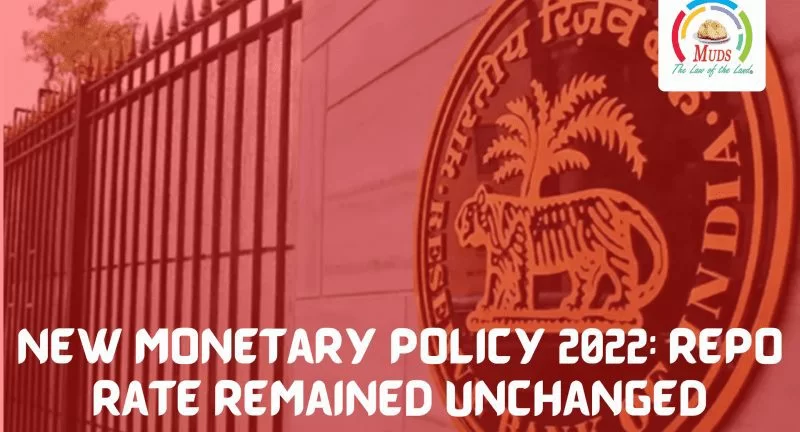New Monetary Policy 2022
Releases from the RBI Monetary Policy 2022 Meeting: The six-member Monetary Policy 2022 Committee (MPC), led by Reserve Bank of India (RBI) Governor Shaktikanta Das, maintained the repo rate at 4% and the reverse repo rate at 3.35 % intact. Here’s what the governor of India’s central bank said.
RBI Monetary Policy 2022: The Reserve Bank of India’s (RBI) Monetary Policy 2022 Committee (MPC) retained the repo rate at 4% for the 11th straight approach achieves a ‘affiliative posture,’ according to RBI Governor Shaktikanta Das on Friday.
The MPC decided unanimously to continue the accommodating approach, according to the central bank governor, and the reverse repo rate was also remained steady at 3.35 percent.
The Marginal Standing Facility (MSF) rates and the lending rate were likewise held steady at 4.25 percent.
On May 22, 2020, the RBI reduced its policy repo rate, or short-term lending rate, in an off-policy cycle to boost demand by decreasing interest rates to a historic low.
In a press conference following the Monetary Policy 2022 meeting, Das stated that the RBI will return the liquidity adjustment facility (LAF) corridor to 50 basis points (bps), as it was pre-Covid. The MSF rate and the bank rate remain at 4.25 percent.
“It also agreed to remain accommodating while concentrating on withdrawal of accommodation to ensure that inflation remains within the goal moving ahead, while encouraging expansion,”
-he added on the central bank’s attitude.
” It will continue to be part of the RBI’s toolbox, and its use will be at the discretion of the RBI for objectives that are indicated from time to time. The FRRR, in conjunction with the SDF, will increase the flexibility of the RBI’s liquidity management framework.”
The RBI reduced its growth prediction for the current fiscal year to 7.2 percent from 7.8 percent previously, while increasing its inflation forecast to 5.7 percent from 4.5 percent.
He went on to say that, given the inordinate volatility in international oil prices as of early February, as well as the extreme uncertainty surrounding the evolving geopolitical tensions, any projection of growth and inflation is fraught with risk, and is largely dependent on future oil and commodity price developments.
Das addressed liquidity and financial market circumstances in his speech, stating that the RBI will continue to take a sophisticated and agile approach to liquidity risk management while preserving appropriate liquidity in the system.
“At the moment, liquidity management is distinguished by two procedures: variable rate reverse repo (VRRR) bids of varied maturities to swallow liquidity, and variable rate repo (VRR) auctions to fill temporary liquidity problems and offset anomalies.” “We will keep taking this strategy,” he stated.
ATM cash withdrawal without a card that is interoperable
In an effort to combat fraud, the Reserve Bank of India agreed on Friday to allow all banks to use card-less cash withdrawal through ATMs. Currently, card-less cash withdrawal via ATMs is a permissible form of transaction allowed by a few banks in the nation on an as-needed basis (for their customers at their own ATMs).
Economic experts and market analysts reacted as follows:
- The severe reduction in GDP forecasts for FY23 and significant increase in inflation expectations for FY23 might suggest some tightening measures in the future, which would be supported by the shift in posture to focus on withdrawal of accommodation. Current geopolitical developments, supply chain concerns, and commodity price increases are tying the RBI’s hands and pushing it to progressively turn hawkish, despite its desire to maintain its pro-growth perspective. The 10-year Gsec yield has increased to 7%, showing the street’s worry over the massive borrowing programme in the face of rising interest rates.”
- “Retaining the repo rate at 4% and the reverse repo rate at 3.35 percent, continuing with the accommodating posture on expected lines,” said V K Vijayakumar, Chief Investment Strategist at Geojit Financial Services. Recognizing the new reality of increased petroleum prices caused by the war, the RBI cut the FY23 GDP growth rate prediction to 7.2 percent from 7.8 percent before and upped the FY23 CPI inflation projection to 5.7 percent from 4.5 percent previously. This is predicated on the premise that crude will be $100 per barrel. This suggests that if crude falls considerably, which is likely if the conflict ends soon, GDP and inflation will improve.The opposite might be true if the battle escalates and petroleum prices rise well beyond $100. The Governor correctly underscored India’s macroeconomic fundamentals, noting to an improvement in the external position aided by record exports, large foreign reserves of $608 billion, and banking sector development. The SDF (Standing Deposit Facility) is a new mechanism established by the central bank to absorb liquidity.
“The recent RBI Monetary Policy 2022 did not include any surprises,” stated Nish Bhatt, Founder & CEO of Millwood Kane International, “it held rates constant for the 11th straight policy.” However, it has clearly outlined the road to policy unwinding. The emphasis will now be on withdrawing the accommodating policy stance in order to keep inflation under control. The RBI’s statement today plainly suggests the end of loose Monetary Policy 2022, which is reflected in the 10-year benchmark yield, which has reached a multi-year high. The unwinding of liquidity will cause some instability, and it is expected that the RBI would drop the growth rate prediction for FY23 to 7.2 percent, with the inflation target raised to 5.7 percent from 4.5 percent previously. The explicit goal of central banks throughout the world is to manage inflation, unwind lose money, and concentrate on gradual and steady development.“


